Roaming Russia – Part I Posteb:by Julian Wicksteed
ROAMING RUSSIA – Part 1
The Urals
Prior to the Russian winter Olympics and prior to Russia’s invasion of the Ukraine, I spent some time exploring some of the lesser travelled corners of Russia’s enormous land mass. I started my wanderings with the two largest cities in the Ural Mountains.
My two month winter trip to Russia started in the city of Chelyabinsk, a city sitting in the southern Ural Mountains, pretty much halfway across Russia and relatively unknown to most of the Western World.
However, the city did briefly leap into the international spotlight on the morning of February the 15th 2013.
With most of the city’s 1.15 million inhabitants at work, at school, or in transit that morning, a meteorite exploded above the city as it passed through the earth’s atmosphere. The meteorite was estimated to be 17 metres in diameter prior to exploding and estimated to possibly weigh up to 11,000 tonnes.
Speaking to people about it while there, they spoke of a blinding flash as bright as the sun, and then, a few minutes later, a shock wave hit the city, imploded windows and doors as though made of paper. Well over 1000 people were said to have immediately dialled for medical assistance, primarily due to glass related injuries. Luckily for Chelyabinsk residents; the explosion, which was believed to be close to thirty times more powerful than the nuclear explosion at Hiroshima, occurred at an altitude beyond 25 kilometres and saved the city from the worst of the shockwave. Remnants of the meteor fell in Chelyabinsk, but its core, now the size of a car; smashed into a frozen lake about 100 kilometres away. If you haven’t seen the footage captured by people driving or at work, it’s well worth a look online.
The funny thing about Chelyabinsk though, is that it is known amongst Russians for different reasons entirely. It was most likely quite well known to the likes of Adolph Hitler and his cronies too . . .
First established in the mid-18th Century as a defensive fort to protect trade routes, it went on to become an important tea and grain packing point on trade routes linking Asia to greater Europe.
By the late 19th Century, the Trans-Siberian Railway had linked Chelyabinsk to the gulags of Siberia and a line had also linked it to Ekaterinburg further north in the Ural Mountains. The city quickly became a transport hub for human labour, some voluntary but most of which was forced. An average of a million people headed east through Clelyabinsk, every year, for a period of 15 years. Not to mention the numbers that would pass through here in the 20th Century under Lenin and Stalin.
Surprisingly though, this is still not why Chelyabinsk is known to Russians.
With the Bolsheviks having snatched power after killing the entire Romanov family in 1918 at the end of World War I, Chelyabinsk experienced rapid industrial growth under Stalin during the 1930s. Two key factories were the tractor plant and Metallurgical plant. Stalin might have been a monster, but he was no fool and didn’t need a crystal ball to see what lay ahead on his western border. With the inevitable advance of the German Army in 1941, Stalin moved his industry east, and with an almost customary ‘scorched earth policy’, he left the Nazis with very little to gain, except long resupply lines, useless narrow gauge railways, and freezing winters.
Chelyabinsk’s tractor factory quickly became a T-34 tank factory. Katyusha rocket launchers were also produced in the city, as were other heavy tanks and multitudes of munition types. During the war, it’s estimated that the Chelyabinsk factories produced close to 20,000 tanks, 50,000 tank engines and well over 17 million units of ammunition. Chelyabinsk quickly became colloquially known as ‘Tankograd’ – Tank City.
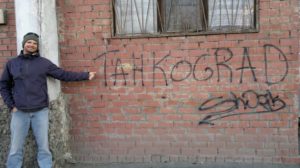
Chelyabinsk – Stalin’s Tank City.
To this day, Chelyabinsk remains a largely industrialised city where metallurgy and armaments still make up a major percentage of production. That said, there are over twelve universities in the city and multiple museums.
Architecturally, much of the city’s development took place under Stalin with his grandiose ‘monumental period’ during industrialisation. These monstrosities were then followed by the socialist housing block developments of the sixties, which swept through much of Eastern Europe. The city isn’t exactly pleasing on the eye.
There are a number of lakes in and around Chelyabinsk, albeit with questionable water quality, so given the typically crisp winter weather, the water and beautiful sunsets were even able to put a shine on the hammer and sickle hewn city of Tankograd.
I never did get out to fish on the frozen lakes near Chelyabinsk before heading off on further travels; primarily due to a lack of opportunity, but also due to reports that the ice wasn’t thick enough yet. Prior to my departure, four locals had already fallen through the ice while fishing and died – I didn’t need to catch a most likely toxic redfin or pike that badly!
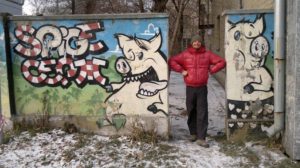
Chelyabinsk grafitti
The primary city of interest for me in the Ural Mountains was Ekaterinburg, and on leaving Chelyabinsk, it was north to there that I travelled.
Ekaterinburg
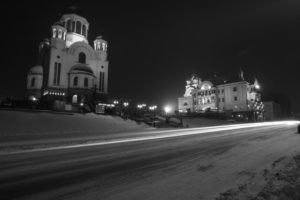
The “Cathedral on the Blood”
Ekaterinburg; pronounced Yekaterinburg, is most definitely known to the Russian people, but not for armament factories, or for meteorite explosions. Instead, it is known for something that was perhaps even more dramatic – an event that would eventually have repercussions throughout the world – not just Russia.
Towards the end of World War I, after centuries of monachal rule in Russia, a large percentage of the Russian people had had enough – they’d definitely had enough of being marched off to die on the Eastern Front, with little more than a few bullets, and a rifle, if lucky.
The communist Bolshevik movement had toppled the Romanov family and Tsar Nicholas II, along with the majority of his family, had been banished to Eketerinburg and imprisoned in the middle of town, in a small building known as Ipatiev house.
On the morning of July the 17th 1918, with the Czechoslovakian army closing in on the city and rumoured to be planning a rescue attempt, the ousted Tsar, his wife Alexandra and their children: Tsarevich, Tatiana, Maria, Anastasia, and Olga, were allegedly lured downstairs for a ‘family photo’. Instead they were greeted with a firing squad, children and all; even the family’s servants were killed. Other members of the family were killed on the same day in the city of Alapayevsk. Whether or not they were killed to avoid having them rescued is open to speculation, but with sulphuric acid used to mutilate the bodies in order to avoid any martyrdom, my guess is that their days were numbered regardless. In 1977, Boris Yeltsin ordered the demolition of Ipatiev house for similar reasons.
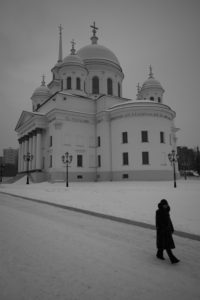
The Cathedrel On The Blood
Since the fall of the Soviet Union, the ‘Cathedral on the Blood’ now stands in its place. The church’s name couldn’t be more literal, because in 1991, it was reported that Russian archaeologists unearthed the remains of two young people here, believed to be Tsarevich 10–13yrs, and Maria 18–23yrs. The rest of the bodies were disposed of down an old mine shaft some 30km out of town.
A relatively new cluster of small wooden churches now stand in remembrance around the mineshaft; each church representing a family member. The Tsar’s remains were exhumed and given a state funeral in Saint Petersburg in July 1998. The remains of the other family members were also disinterred and buried elsewhere. With some of the churches serving as museums and the mouth of the unpropitious mineshaft lit by candles, it makes for an eerie and moving visit on a cold winter’s day.
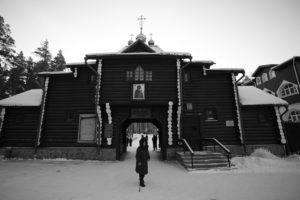
Entrance to the Romanov memorial, the murdered Romanov children, and the mine shaft.
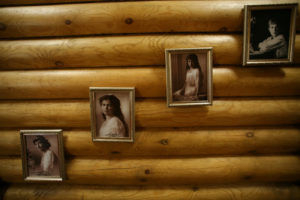
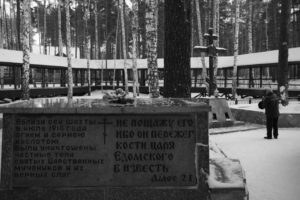
The city of Ekaterinburg itself was founded in 1723 and named after Tsar Peter the Great’s wife, Catherine Yekaterina. It quickly became one of Russia’s key industrial cities, but as the need for iron and metallurgy waned and trade boomed, beautiful administrative buildings built from stone lifted the city’s appearance. Ekaterinburg didn’t escape the Bolshevik industrial boom of the 1930s though, or the relocation of industry during World War II. On the outskirts, it also didn’t escape the 1960s housing block developments.
With lakes being a feature of the older town centre, it is quite a spectacular city, particularly of a night time when buildings such as the Cathedral on the Blood are lit up. Wandering the city here while trying to stay on my feet in the snow and ice, I couldn’t help but wonder, ‘what if?’
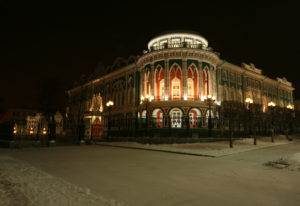
Blanketed in snow and lit up by night, many of Ekatarinburg’s buildings were truly beautiful.
As with most aristocracies in the 19th Century, chances are the Russian people had every right to be fed up with the Romanov family, but had the entire bloodline not been exterminated, how would Russia be today – how would the rest of the world be I wonder? I guess we’ll never know …
Find more of Julian Wicksteed’s written and photographic work at:





